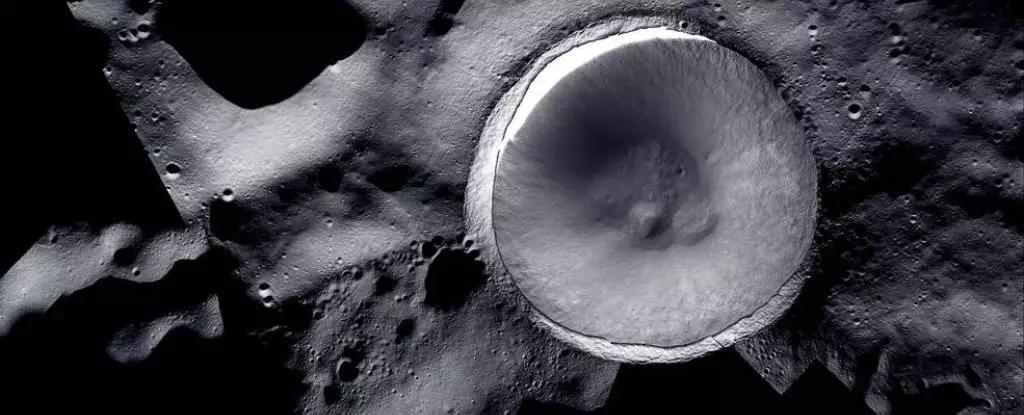A recent groundbreaking image from NASA has unveiled the hidden secrets of the Moon’s dark side. Through a unique blend of photographs taken by two different cameras, a previously unexplored crater on the lunar south pole called Shackleton Crater has been brought to light. This ancient pockmark, nestled within the mountainous region, has remained hidden from the sun’s rays for billions of years, casting shadows that create intriguing possibilities of water-ice existence. As astronomers eagerly seek answers, NASA’s innovative “night goggles” and a Chinese plan to send a mini flying probe offer hope for unraveling the mysteries hidden within this cold, enigmatic world.
Shackleton Crater, a captivating feature of the lunar landscape, resides in the shadowy depths of the moon’s mysterious south pole. Due to the moon’s tilt, only the highest ridges and peaks are bathed in sunlight, leaving the rest of the region largely obscured. These shadowy areas, known as “cold traps,” present opportunities for water or ice to hide away from both the Sun’s glare and the inquisitive gaze of astronomers. The temperature within the dark recesses of Shackleton Crater plunges to staggering lows, reaching a chilling -173 °C (-280 °F). If water vapor from a primordial comet crash resides within the crater, it is likely frozen beneath the surface, eluding detection. Set to launch in 2026, a mini flying probe from China aims to drill into Shackleton Crater to gather evidence of lunar water-ice. Until then, NASA relies on its revolutionary “night goggles” to peer into the perpetual darkness and shed light on this enigmatic realm.
To bridge the gap of the unilluminated lunar south pole, NASA devised a remarkable solution – ShadowCam. This specially designed device, launched aboard a Korean lunar satellite in August 2022, enables us to witness our celestial neighbor like never before. ShadowCam surpasses other lunar cameras in sensitivity to light in shadowed regions, capturing the dark lunar surface using a technique called “earthshine.” This method utilizes the reflection of light from our planet to illuminate the moon, revealing its hidden beauty. Additionally, the camera harnesses the reflection of sunlight from rugged lunar mountains and ridges. However, an inherent limitation leads to over-saturation when imaging bright regions. Notably, when attempting to capture Shackleton Crater, only a small portion of the crater is exposed to sunlight for 90% of the year. Consequently, the sunlit segments appeared washed out in the initial images taken by ShadowCam.
To counter the loss of detail caused by over-saturation, the ShadowCam team devised an ingenious solution – an image mosaic. By replacing the overexposed, sunlit regions with photographs from other lunar cameras in orbit, a comprehensive visual map of the entire scene can be constructed with breathtaking precision. This unprecedented mosaic provides analysts with optimized imagery, offering unrivaled insights into the terrain and geologic features of both the brightest and darkest realms of the Moon. The combination of images from multiple instruments creates a vivid representation of Shackleton Crater, enabling scientists to study its secrets with renewed enthusiasm and a fresh perspective.
As the hidden mysteries of Shackleton Crater are gradually illuminated, scientists around the world eagerly await the revelations that lie within. This remarkable endeavor not only promises to unlock the secrets of this ancient crater but also holds broader implications for our understanding of the moon’s history and potential for sustaining life. By peering into the depths of the Moon’s dark side, humanity’s quest for knowledge pushes the boundaries, offering excitement and hope for future lunar explorations. As we continue to explore the wonders of our cosmic neighborhood, the enigma of Shackleton Crater serves as a captivating reminder that the mysteries of the universe are as abundant as they are beguiling.


Leave a Reply